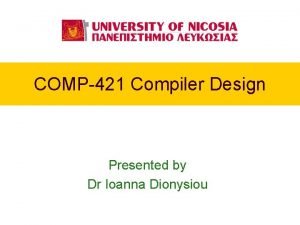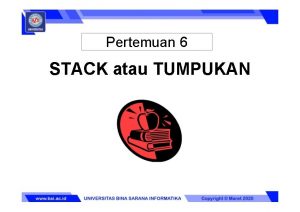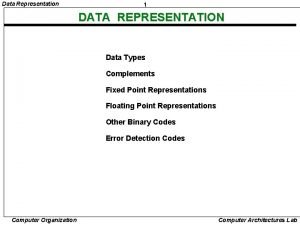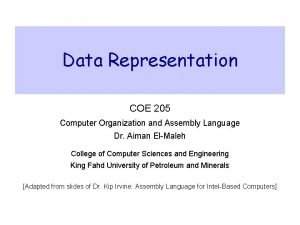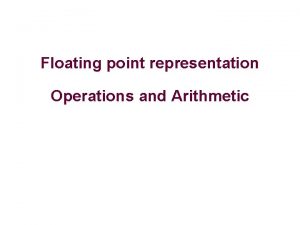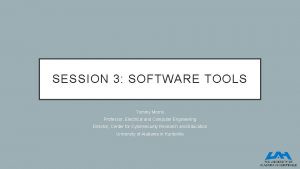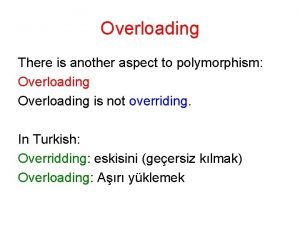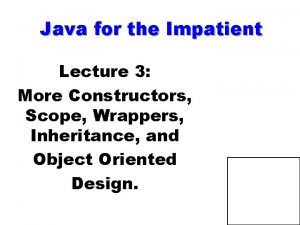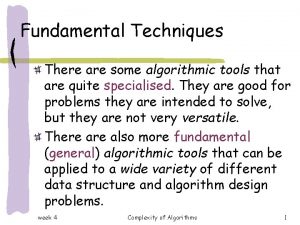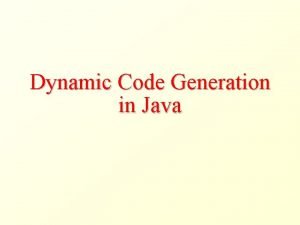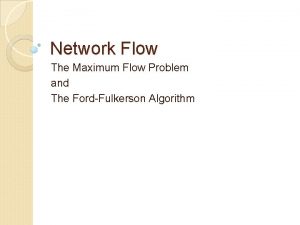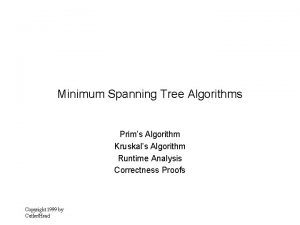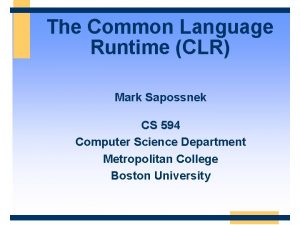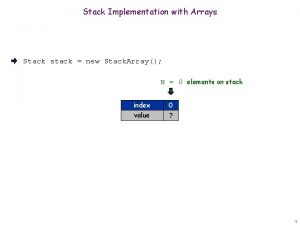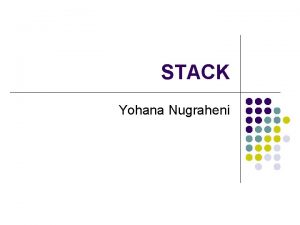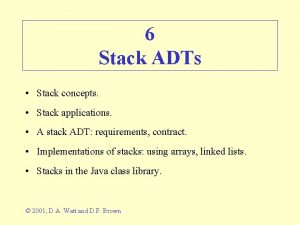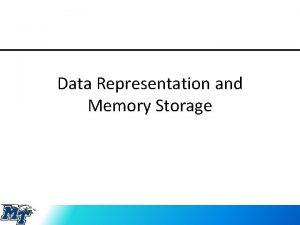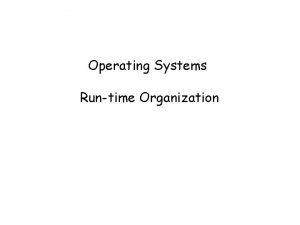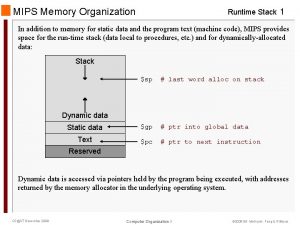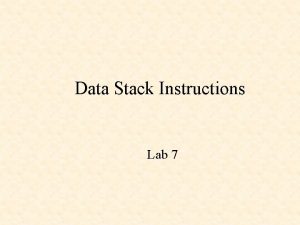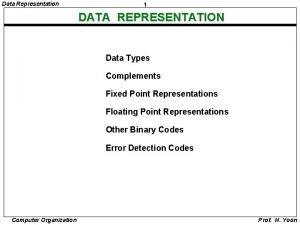14 Runtime organization Data representation Storage organization stack





![Example: representation of C arrays § C type definition: typedef int[] Arr; Assume size Example: representation of C arrays § C type definition: typedef int[] Arr; Assume size](https://slidetodoc.com/presentation_image_h2/028a3e3ca3cd7116350caf70d58c1300/image-6.jpg)























- Slides: 29

14 Run-time organization § Data representation § Storage organization: – stack – heap – garbage collection Programming Languages 3 © 2012 David A Watt, University of Glasgow 14 -1

Data representation § Assumptions: – The PL is statically-typed. – The compiler decides the size and layout of each type. – All variables of the same type have the same size. § Here consider representation of: – primitive types – cartesian products – arrays – objects. 14 -2

Representation of primitive types § Representation of each primitive type may be language-defined or implementation-defined. § Typically 8, 16, 32, or 64 bits. § BOOL: 0000 or 00000001. § CHAR: 0000, …, 1111 (if 8 -bit) § INT: 16 -bit or 32 -bit or 64 -bit twos-complement. § FLOAT: 32 -bit or 64 -bit IEEE floating-point. 14 -3

Representation of arrays (1) § Represent an array by juxtaposing its components. § Represention of arrays of type {0, 1, 2, …} → T: … component 2 component 1 components of the same type, with the same size component 0 base 14 -4

Representation of arrays (2) § The offset of array component i (relative to the array’s base address) is linearly related to i: offset of component i = (size of type T) × i known to the compiler unknown § Since i is unknown, the offset of component i must be calculated at run-time. 14 -5
![Example representation of C arrays C type definition typedef int Arr Assume size Example: representation of C arrays § C type definition: typedef int[] Arr; Assume size](https://slidetodoc.com/presentation_image_h2/028a3e3ca3cd7116350caf70d58c1300/image-6.jpg)
Example: representation of C arrays § C type definition: typedef int[] Arr; Assume size of § Possible representation of values of type Arr: 14 -6

Representation of cartesian products (1) § Represent a tuple (or record or struct) by juxtaposing its components. § Representation of tuples of type T 1 ´ T 2 ´ ´ T n: component n … component 3 components of different types, with different sizes component 2 component 1 base 14 -7

Representation of cartesian products (2) § The compiler knows the offset of each tuple component (relative to the tuple’s base address): offset of component 1 = 0 offset of component 2 = size of type T 1 offset of component 3 = size of type T 1 + size of type T 2 … offset of component n = size of type T 1 + size of type T 2 +. . . + size of type Tn– 1 all sizes known to the compiler 14 -8

Example: representation of C structs § C struct type definition: struct Str { float f; int n; char c; }; Assume sizes: FLOAT 4 bytes § Possible representation of structs of type Str: c (offset 6) n (offset 4) f (offset 0) 14 -9

Representation of objects (1) § Recall: Objects are tagged tuples. § Represent an object by juxtaposing its components (instance variables) with a class tag. 14 -10

Representation of objects (2) § Consider class C with components (instance variables) of types T 1, , Tn. § Representing objects of class C: component of type Tn … C component of type T 1 class tag base components of different types, with different sizes § The compiler knows the offset of each component (relative to the object’s base address). 14 -11

Representation of objects (3) § Now consider class C' (a subclass of C) with additional instance variables of types T'1, , T'm. § Representation of objects of classes C and C': component of type T'm component of type T'1 component of type Tn … C component of type T 1 class tag C' § Each component has a known offset in objects of a given class C and all subclasses of C. 14 -12

Example: representation of Java objects (1) § Java class declarations: class Shape { int x, y; … } class Circle extends Shape { int r; … } class Box extends Shape { int w, h; boolean rd; // true if corners are rounded … } 14 -13

Example: representation of Java objects (2) § Representing objects of above classes (simplified): rd h Shape r w y y y x x x Circle Box class tag 14 -14

Storage organization § Each variable occupies storage space throughout its lifetime. That storage space must be: – allocated at the start of the variable’s lifetime – deallocated at the end of the variable’s lifetime. § Assumptions: – The PL is statically typed, so every variable’s type is known to the compiler. – All variables of the same type occupy the same amount of storage space. 14 -15

Storage for global and local variables (1) § Recall: A global variable’s lifetime is the program’s entire run-time. § For global variables, the compiler allocates fixed storage space. § Recall: A local variable’s lifetime is an activation of the block in which the variable is declared. The lifetimes of local variables are nested. § For local variables, the compiler allocates storage space on a stack. 14 -16

Storage for global and local variables (2) § At any given time, the stack contains one or more activation frames: – The frame at the base of the stack contains the global variables. – For each active procedure P, there is a frame containing P’s local variables. An active procedure is § A frame for procedure P is: one that has been – pushed on to the stack when P is called but – popped off the stack when P returns. not yet returned. 14 -17

Storage for global and local variables (3) § The compiler fixes the size and layout of each frame. § The offset of each global/local variable (relative to the base of the frame) is known to the compiler. 14 -18

Example: storage for global and local variables in SVM (1) § SVM data store when the main program has called P, and P has called Q: § sp (stack pointer) points to the first free cell above the top of the stack. § fp (frame pointer) points to the first cell of the topmost frame. sp free Q’s locals fp return address dynamic link P’s locals return address dynamic link globals frame for Q frame for P global frame 14 -19

Example: storage for global and local variables in SVM (2) § Effect of calls and returns: call P call Q free return sp Q’s locals fp sp P’s locals sp fp globals P’s locals fp globals 14 -20

Storage for heap variables (1) § Recall: A heap variable’s lifetime starts when the heap variable is created and ends when it is destroyed or becomes unreachable. The lifetimes of heap variables follow no pattern. § Heap variables occupy a storage region called the heap. At any given time, the heap contains all currently-live heap variables, interspersed with free space. – When a new heap variable is to be created, some free space is allocated to it. – When a heap variable is to be destroyed, its allocated space reverts to being free. 14 -21

Storage for heap variables (2) § The heap manager (part of the PL’s run-time system) keeps track of free space within the heap – usually by means of a free-list: a linked list of free areas of various sizes. § The heap manager provides: – a routine to create a heap variable (called by the PL’s allocator) – a routine to destroy a heap variable (called by the PL’s deallocator, if any). 14 -22

Example: storage for heap variables § Effect of allocations and deallocations: allocate e c. right=e d. succ=a deallocate b stack free e e d d d c c c b b free a a a free heap 14 -23

Garbage collection § If the PL has no deallocator, the heap manager must be able to find and destroy any unreachable heap variables automatically. This is done by a garbage collector. § A garbage collector must visit all reachable heap variables. This is inevitably time-consuming. § A mark-sweep garbage collector is the simplest. It first marks all reachable heap variables, then deallocates all unmarked heap variables. 14 -24

Mark-sweep garbage collection algorithm § Mark-sweep algorithm: To mark all heap variables reachable from pointer p: 1 Let heap variable v be the referent of p. 2 If v is unmarked: depth-first 2. 1 Mark v. traversal 2. 2 For each pointer q in v: 2. 2. 1 Mark all heap variables reachable from q. To collect garbage: 1 For each pointer p in a global/local variable: 1. 1 Mark all heap variables reachable from p. 2 For each heap variable v: 2. 1 If v is unmarked, destroy v. 2. 2 Else, if v is marked, unmark v. 14 -25

Example: mark-sweep garbage collection § Effect of mark and sweep: mark sweep stack heap free e d d d c c c b b free a a a 14 -26

Issues § Time complexity of mark-sweep garbage collection is O(nr + nh) – nr = number of reachable heap variables – nh = total number of heap variables. § The heap tends to become fragmented: – There might be many small free areas, but none big enough to allocate a new large heap variable. – Partial solution: coalesce adjacent free areas in the heap. – Better solution: use a copying or generational garbage collector. 14 -27

Copying garbage collector § A copying garbage collector maintains two separate heap spaces: – Initially, space 1 contains all heap variables; space 2 is spare. – Whenever the garbage collector reaches an unmarked heap variable v, it copies v from space 1 to space 2. – At the end of garbage collection, spaces 1 and 2 are swapped. § Pros and cons: + Heap variables can be consolidated when copied into space 2. – All pointers to a copied heap variable must be found and redirected from space 1 to space 2. 14 -28

Generational garbage collector § A generational garbage collector maintains two (or more) separate heap spaces: – One space (the old generation) contains only long-lived heap variables; the other space (the young generation) contains shorter-lived heap variables. – The old generation is garbage-collected infrequently (since long-lived heap variables are rarely deallocated). – The young generation is garbage-collected frequently (since short-lived heap variables are often deallocated). – Heap variables that live long enough may be promoted from the young generation to the old generation. § Pro: + Garbage collection is more focussed. 14 -29
 Runtime environment in compiler design
Runtime environment in compiler design Primary storage vs secondary storage
Primary storage vs secondary storage Stack smash attack
Stack smash attack Stack pointer definition
Stack pointer definition Diketahui suatu stack dgn max_stack = 6
Diketahui suatu stack dgn max_stack = 6 Data representation in computer architecture
Data representation in computer architecture Data representation in computer organization
Data representation in computer organization Data representation and organization
Data representation and organization Data types and representation
Data types and representation Data representation in computer organization
Data representation in computer organization Storage devices of computer
Storage devices of computer Secondary storage provides temporary or volatile storage
Secondary storage provides temporary or volatile storage Object based and unified storage
Object based and unified storage Floating point number meaning
Floating point number meaning List and explain different subdivisions of run-time memory
List and explain different subdivisions of run-time memory System programming definition
System programming definition Openplc arduino
Openplc arduino Compile time polymorphism java
Compile time polymorphism java Kinect for windows runtime
Kinect for windows runtime Constructor java
Constructor java Heapify runtime
Heapify runtime Matrix multiplication time complexity
Matrix multiplication time complexity Runtime error index out of bounds
Runtime error index out of bounds Dynamic class loading in java
Dynamic class loading in java Ford fulkerson runtime
Ford fulkerson runtime Prims algorithm runtime
Prims algorithm runtime Basic runtime checks
Basic runtime checks Runtime errors examples
Runtime errors examples Clr c#
Clr c# Heapify runtime
Heapify runtime
